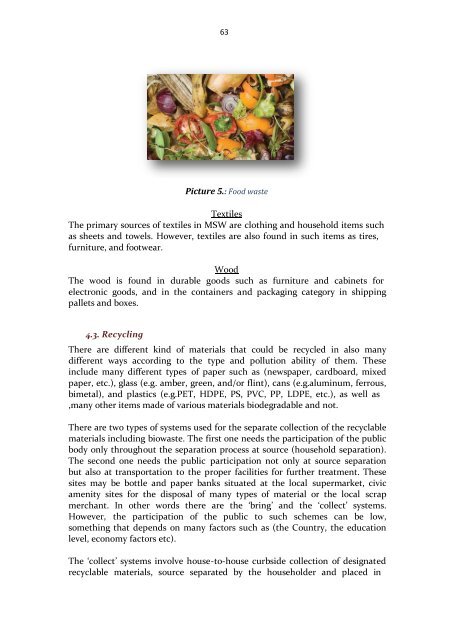(best examples and good practices) on household organic waste ...
(best examples and good practices) on household organic waste ... (best examples and good practices) on household organic waste ...
63 Picture 5.: Food waste Textiles The primary sources of textiles in MSW are clothing
64 separate containers. There are a number of varieties of the ‘collect’ system. For example, the recyclable materials are all placed in one container; therefore the mixture has to be sorted, either by processing equipment or by h
- Page 23 and 24: 12 Picture2.: View of machine used
- Page 25 and 26: 14 In-Vessel Composting Systems In
- Page 27 and 28: 16 The duration of the composting p
- Page 29 and 30: 18 Figure 7.: Principal emissions f
- Page 31 and 32: 20 2.2 Anaerobic Digestion (AD) 2.2
- Page 33 and 34: 22 4. Finally, methanogenic organis
- Page 35 and 36: 24 If the proper conditions cannot
- Page 37 and 38: 26 Considerations such as the desig
- Page 39 and 40: 28 to the viscosity of the feed, th
- Page 41 and 42: 30 The Netherlands
- Page 43 and 44: 32 Heavy metals in digestate usuall
- Page 45 and 46: 34 3. Large scale biodegradable was
- Page 47 and 48: 36 power and 1,200
- Page 49 and 50: 38 filtration or electrostatic prec
- Page 51 and 52: 40 acceptable range, but reduce the
- Page 53 and 54: 42 Rotary kiln furnaces Rotary kiln
- Page 55 and 56: 44 It has been processed an
- Page 57 and 58: 46 Heavy metals can be grouped into
- Page 59 and 60: 48 choices for a commercial plant w
- Page 61 and 62: 50 Gasification (Figure.19) using o
- Page 63 and 64: 52 AC plasma CO2 plasma arc Microwa
- Page 65 and 66: 54 pulled through an induced draft
- Page 67 and 68: 56 the non-biodegradables a
- Page 69 and 70: 58 3.3.8. Bioreactor land</
- Page 71 and 72: 60 4. Materials Sorting Processes 4
- Page 73: 62 Plastics Plastics (Fiqure.32) po
- Page 77 and 78: 66 The sorting of recyclables may b
- Page 79 and 80: 68 4.5. Mechanical and</str
- Page 81 and 82: 70 glass breakage on the tipping fl
- Page 83 and 84: 72 within solution under the influe
- Page 85 and 86: 74 material, and t
- Page 87 and 88: 76 changing pole configuration or w
- Page 89 and 90: 78 4.7. Mechanical Biological Treat
- Page 91 and 92: 80 Biological processing compartmen
- Page 93 and 94: 82 equivalence considerations <stro
- Page 95 and 96: 84 5.2. Waste streams considered in
- Page 97 and 98: 86 Figure 27.: Percentage of munici
- Page 99 and 100: 88 6.Italy The Italian strategy Ita
- Page 101 and 102: 90 Italy also set targets for colle
- Page 103 and 104: 92 (Figure 30.). The quality of com
- Page 105 and 106: 94 a controlled environment with wa
- Page 107 and 108: 96 Picture 11.: The Corteolona plan
- Page 109 and 110: 98 The building in the foreground h
- Page 111 and 112: 100 compost their garden waste. The
- Page 113 and 114: 102 The total amount of waste produ
- Page 115 and 116: 104 7. Germany 7.1. Waste managemen
- Page 117 and 118: 106 has been specified only for som
- Page 119 and 120: 108 7.3. Best practices</st
- Page 121 and 122: 110 The installation has different
- Page 123 and 124: 112 The sludge is placed into a lar
63<br />
Picture 5.: Food <strong>waste</strong><br />
Textiles<br />
The primary sources of textiles in MSW are clothing <str<strong>on</strong>g>and</str<strong>on</strong>g> <strong>household</strong> items such<br />
as sheets <str<strong>on</strong>g>and</str<strong>on</strong>g> towels. However, textiles are also found in such items as tires,<br />
furniture, <str<strong>on</strong>g>and</str<strong>on</strong>g> footwear.<br />
Wood<br />
The wood is found in durable <str<strong>on</strong>g>good</str<strong>on</strong>g>s such as furniture <str<strong>on</strong>g>and</str<strong>on</strong>g> cabinets for<br />
electr<strong>on</strong>ic <str<strong>on</strong>g>good</str<strong>on</strong>g>s, <str<strong>on</strong>g>and</str<strong>on</strong>g> in the c<strong>on</strong>tainers <str<strong>on</strong>g>and</str<strong>on</strong>g> packaging category in shipping<br />
pallets <str<strong>on</strong>g>and</str<strong>on</strong>g> boxes.<br />
4.3. Recycling<br />
There are different kind of materials that could be recycled in also many<br />
different ways according to the type <str<strong>on</strong>g>and</str<strong>on</strong>g> polluti<strong>on</strong> ability of them. These<br />
include many different types of paper such as (newspaper, cardboard, mixed<br />
paper, etc.), glass (e.g. amber, green, <str<strong>on</strong>g>and</str<strong>on</strong>g>/or flint), cans (e.g.aluminum, ferrous,<br />
bimetal), <str<strong>on</strong>g>and</str<strong>on</strong>g> plastics (e.g.PET, HDPE, PS, PVC, PP, LDPE, etc.), as well as<br />
,many other items made of various materials biodegradable <str<strong>on</strong>g>and</str<strong>on</strong>g> not.<br />
There are two types of systems used for the separate collecti<strong>on</strong> of the recyclable<br />
materials including bio<strong>waste</strong>. The first <strong>on</strong>e needs the participati<strong>on</strong> of the public<br />
body <strong>on</strong>ly throughout the separati<strong>on</strong> process at source (<strong>household</strong> separati<strong>on</strong>).<br />
The sec<strong>on</strong>d <strong>on</strong>e needs the public participati<strong>on</strong> not <strong>on</strong>ly at source separati<strong>on</strong><br />
but also at transportati<strong>on</strong> to the proper facilities for further treatment. These<br />
sites may be bottle <str<strong>on</strong>g>and</str<strong>on</strong>g> paper banks situated at the local supermarket, civic<br />
amenity sites for the disposal of many types of material or the local scrap<br />
merchant. In other words there are the ‘bring’ <str<strong>on</strong>g>and</str<strong>on</strong>g> the ‘collect’ systems.<br />
However, the participati<strong>on</strong> of the public to such schemes can be low,<br />
something that depends <strong>on</strong> many factors such as (the Country, the educati<strong>on</strong><br />
level, ec<strong>on</strong>omy factors etc).<br />
The ‘collect’ systems involve house-to-house curbside collecti<strong>on</strong> of designated<br />
recyclable materials, source separated by the <strong>household</strong>er <str<strong>on</strong>g>and</str<strong>on</strong>g> placed in



